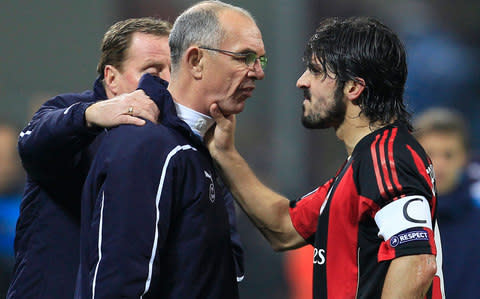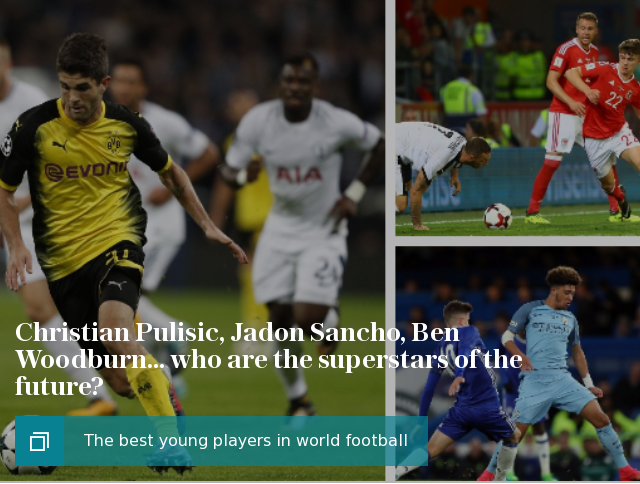Gennaro Gattuso puts the bite back into AC Milan's dugout but has a battle to turn toiling team's fortunes

Rino Gattuso has never been bashful about his belligerence. The AC Milan manager had clocked only 10 days in the job before his side’s dead rubber Europa League defeat by Rijeka last Thursday compelled Ringhio, 'the Growl’, to betray his disgruntlement with his charges. “We have got to change direction,” he said. “Because we are going nowhere like this. When you wear the Milan jersey, you need to respect it. When we get a punch in the teeth, I get the feeling we never recover.”
The World Cup-winning midfielder, a consummate scuffler who won two Champions Leagues and two Serie A titles in 13 years at the club, once butted the Tottenham coach Joe Jordan, a venture most who knew anything about the abrasive former Leeds United, Manchester United, Scotland and, yes, Milan centre-forward would happily swap with a kamikaze commission. In 2003 he was sent off for slapping the 6ft 5in Zlatan Ibrahimovic in the face and though the two ended up as team-mates during Milan’s last scudetto-winning campaign in 2010-11, the incorrigible Ibrahimovic had his revenge for that episode and a few salty training ground words, by picking Gattuso up and depositing him head first into a dressing room bin.
One wonders if that is the kind of response Gattuso would welcome now. At least it shows some spirit. “When I lost a match I broke down in frustration,” he said. “Today players lose, take a selfie and put it on the internet. They make me sick.”
It’s an attitude - a kind of disgust - that aligns a manager with supporters whose exasperation during six years of decline has curdled into revulsion and open revolt. It is also dangerous in two senses - firstly in a volatile football culture where fans are not unafraid of physical confrontation with players it could be misinterpreted. Secondly, although owners think they want a hardline approach, a disciplinarian to kick backsides and focus minds on a common purpose, they rarely have the stomach to see it through should the merest whiff of player alienation and resistance emanate from the training ground.
Think of the clubs who appoint an insurgent to transform the atmosphere and practices - Real Madrid with John Toshack’s second appointment, say, or Paolo Di Canio at Sunderland - and before too long points of principle are sacrificed, along with the taskmaster, in pursuit of peace.
And the trigger point usually follows public criticism of a player, a line Gattuso flirted with when addressing the travails of his £34m centre-forward in Croatia. “We all know his qualities, he's a player of international level,” he said. "He struggled today, he looked like a foreign object in the team. When you have the opportunity to play for 90 minutes wearing AC Milan's shirt you have to do more.”

He has been in charge for only two games - a 2-2 draw with Benevento whose goalkeeper scored a 95th-minute equaliser to claim their first point of the season after 14 lost league matches - and the defeat by Rijeka that did not affect Milan’s place at the top of Europa League Group D in their first continental campaign for four seasons. Both set-backs were palpably the players’ fault but managers are always dispensable no matter their service and loyalty, especially at Milan.
Mauro Tassotti and Cristian Brocchi, like Gattuso, have moved up from the youth department to run the first team in caretaker roles but left the club after not getting the full-time job while Clarence Seedorf and Pippo Inzaghi, team-mates of Gattuso, have also endured stints in charge since the club sacked Max Allegri in 2014. Twice during the past 3½ years they have looked outside and appointed Sinisa Mihajlovic and Vincenzo Montella but neither, despite winning one in two league games, have convinced an impatient club that they have solved the long-standing problems of brittleness and inconsistency.
Despite a huge churn of players, systemic reform at youth and academy level, the hard work of elite development and fostering club culture, was avoided in preference for the quick fix – give the manager’s job to a favoured son and demand a miracle.
Where Silvio Berlusconi had the drive 20 years before to rebuild an institution, the club was in the business of providing instant gratification on the cheap for the six years since their 2011 title until he finally completed the sale to Rossoneri Sport Investment last spring. It was a convoluted deal involving the stipulated payment of instalments, one of which was rescheduled, to Li Yonghong’s Luxembourg-based holding company. The €740m deal, it later emerged, was partly financed by a €303m bridging loan from Elliott Management, the New York hedge fund firm, repayable next November at an interest rate of 11.5 per cent for the first €180m and 7.7% on the remainder. Small wonder Li’s investment vehicle is looking to refinance before then because the conditions attached to the loan, as well as the eye-watering rate, means any default hands ownership of the club to the ‘vulture fund’.

In addition to the mechanics of the serpentine takeover process and timetable, the specifics of Li’s business interests in China have been queried and his disputes with regulators there detailed by the New York Times last month. Like other things in Europe, the takeover has hardly led to the broad, sunlit uplands of institutional rejuvenation.
Back in the summer of 2015, Berlusconi splurged €80m on five players but without a proper structure in place succeeded only in moving up from 10th to 7th in the league in spite of Carlos Bacca’s 18 goals. Before this season they spent €230m, bringing in Leonardo Bonucci, Andre Silva, Andrea Conti, Hakan Calhanoglu, Ricardo Rodriguez, Mateo Musacchio, Lucas Biglia, Franck Kessie, Nikola Kalinic and Fabio Borini.
Bonucci, a terrific centre-back at Juventus and designed to be a talismanic signing, has been woeful, even though Montella switched to a back three after the 4-1 defeat by Lazio in September. His effort is conspicuous but the concentration lapses that persuaded Inter to let him go 10 years ago have returned as he tries to inspire a skittish team spooked by the crowd’s irritation. All the positives of his game at Juventus, the way he galloped forward or started attacks with diagonal, chipped passes are of little use to an anxious, dysfunctional team and the change of system has unnerved the excellent Alessio Romagnoli. Moreover the multiplicity of unsatsfactory options has fostered indecisive selection: Montella selected 20 different starters in 14 league games.

More than anything, the incontinent spree exposes a fundamental flaw with their recruitment process. Hardly any of Milan’s recent big money signings have prospered and the majority of them have been bombed out within a couple of years. Alessandro Matri, Luiz Adriano, Andrea Bertolacci, Gianluca Lapadula and Bacca were all brought in for significant fees over the past three season and each has already left for a loss apart from Bacca who is out on loan at Sevilla but has no desire to come back.
So far they have been beaten by Empoli, Lazio, Sampdoria, Roma, Inter and Napoli and have not scored at home in the league since Sept 20. A club that has spent heavily and is in the midst of complex, crucial refinancing negotiations said at the start of the season that Champions League qualification was an imperative. As it has to be for those who do not own their own stadiums and are trying to break into the top end of the Far East merchandising market. It’s where the money that would allow them to compete with Real Madrid, Barcelona, Juventus, Manchester United, Bayern Munich and the petrodollar giants has to come from. They are currently 13 points off fourth place which makes winning the Europa Cup an attractive alternative. Such a disjointed performance against Rijeka, therefore, has rattled even more cages.

In some circumstances Gattuso is the ideal hair shirt manager. The Pisa side he led to promotion to Serie B in 2016 were extraordinarily hard working and though they were relegated in 21st place at the end of their their first season back up after being unable to strengthen the squad significantly, they managed to draw 21 of 42 games and conceded only 36 goals, the second lowest in the division. That they managed to score a mere 23, however, illustrates that the virtues of diligence, discipline, coherent organisation, unyielding passion and commitment can only do so much to compensate for a lack of talent and invention.
But even in those reduced circumstances, Gattuso managed to impose a coherent structure on the team, if not the club. At Milan that will not be enough. The problems with the team are a symptom of what is wrong with the club and introducing some bite in the dug-out because they have no bite on the pitch can only be a short-term solution. Gattuso can preach as much as he likes about the Milan way and the duty the players owe to the shirt but when you have new owners, new executives and new players the transfusion takes a lot longer. He may sort the defence out because that has been his forte but the success of ‘management by hand grenade’, as the former Swindon CEO, Nick Watkins, described Paolo Di Canio’s approach, is typically fleeting.

After five topsy-turvy seasons of decline, it is preposterous to think a turnaround could be achieved by Montella, a manager who has never qualified for the Champions League, and seemingly scattergun recruitment. It’s a long road back for the second most successful club in European history and establishing firm foundations with the investment would have seemed more logical than a dash for glory but perhaps with the loan the takeover vehicle required and its terms, it had to be that way. Prudence is rarely the seductive option but onfield it is likely to be Gattuso’s most effective approach and the 15,000 increase on average attendances from last season in the seven games so far is a positive sign amid the muddle. A goal against Bologna at San Siro on Sunday night would be an overdue step forward.

 Yahoo Sport
Yahoo Sport 





































